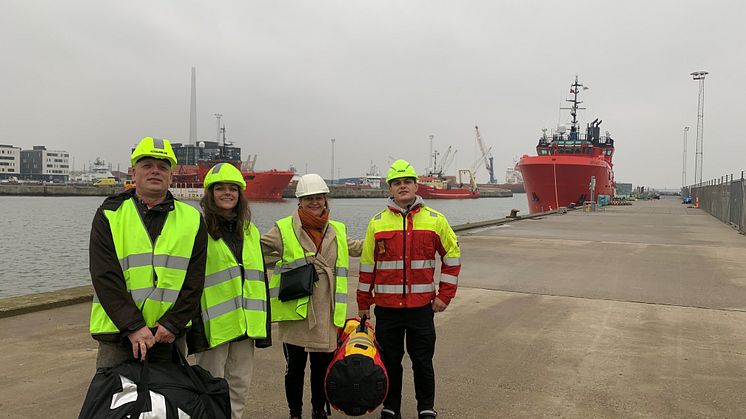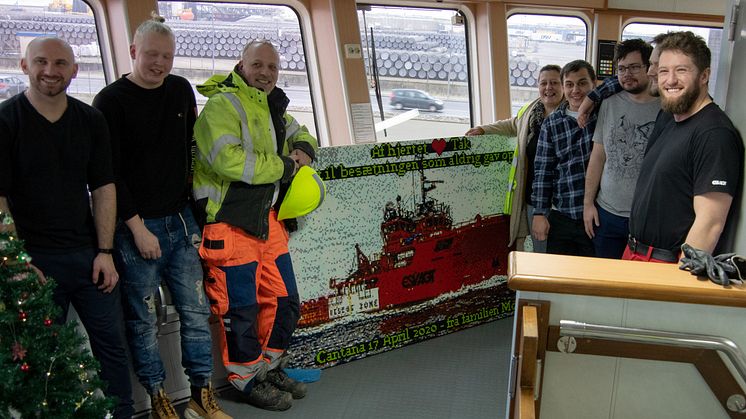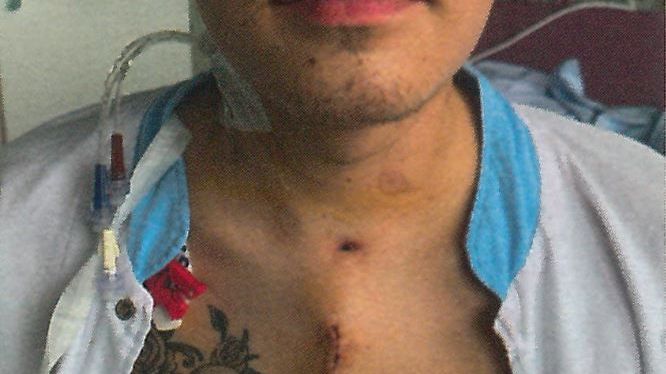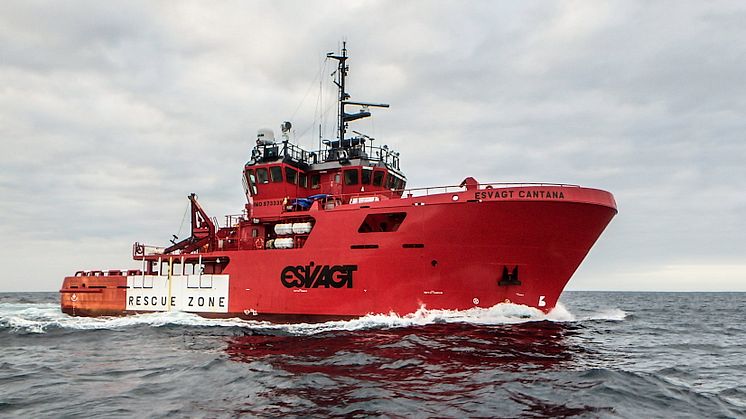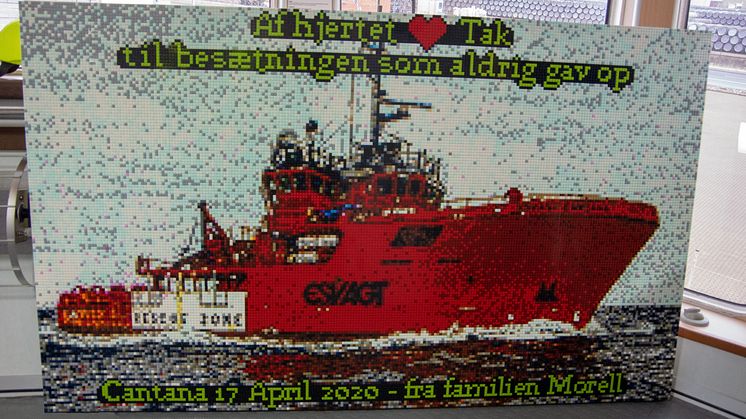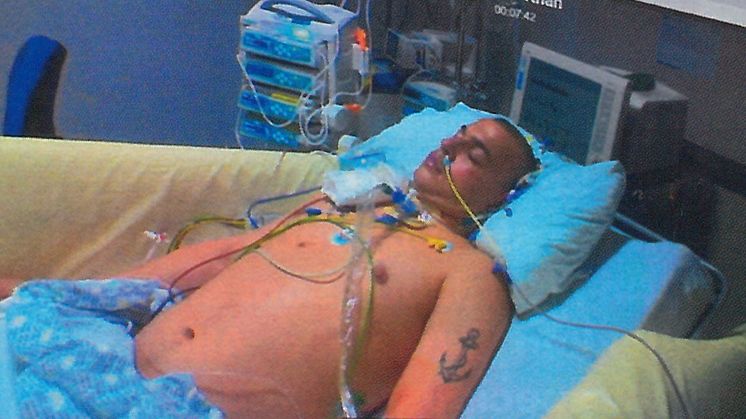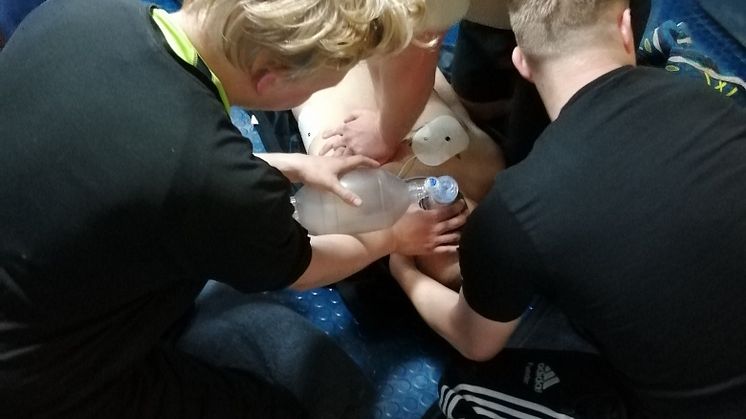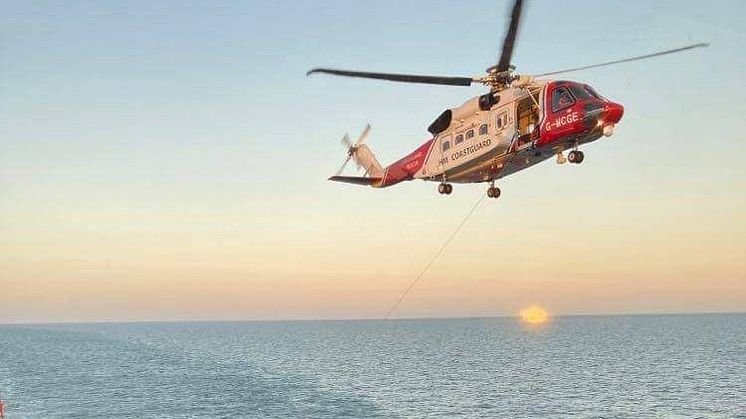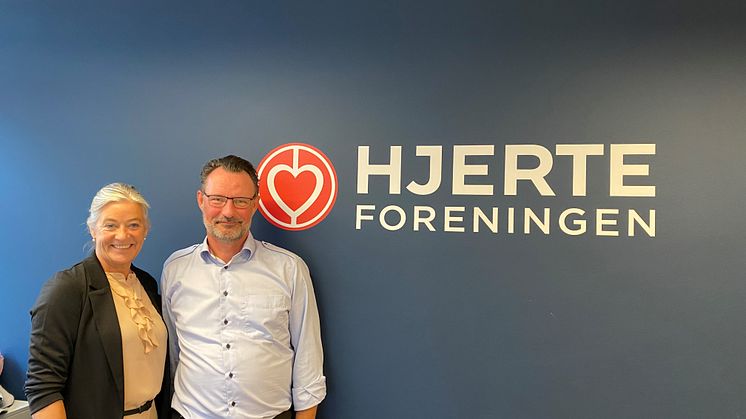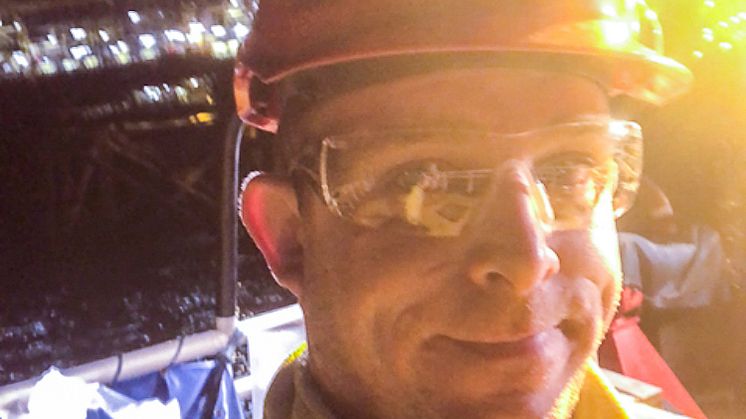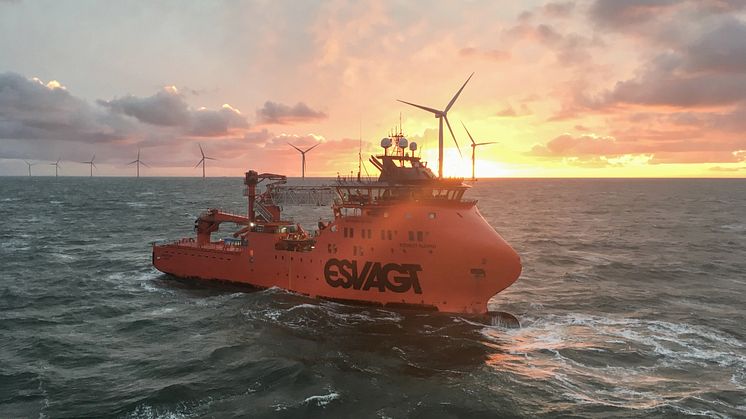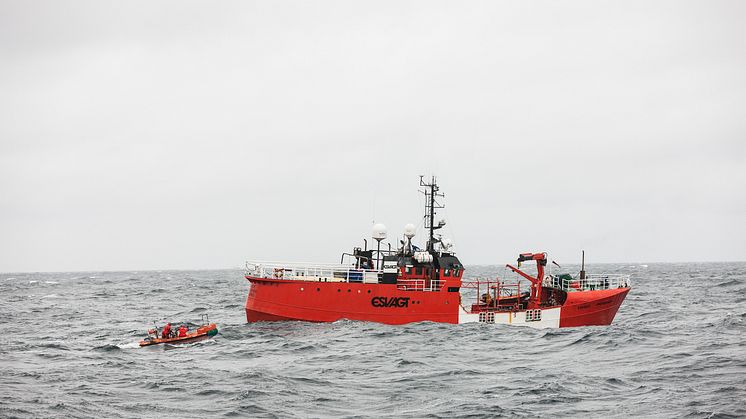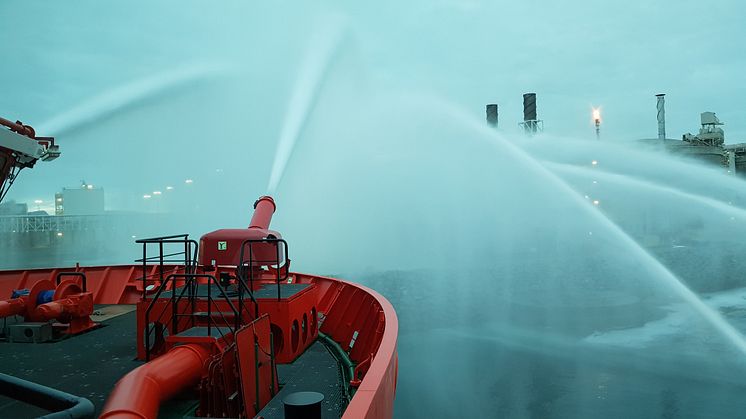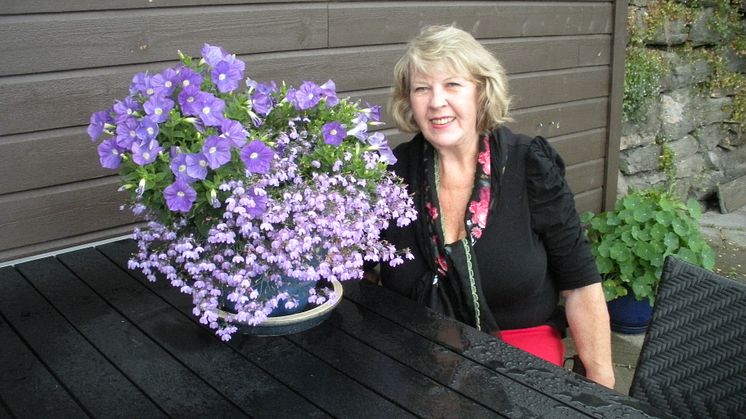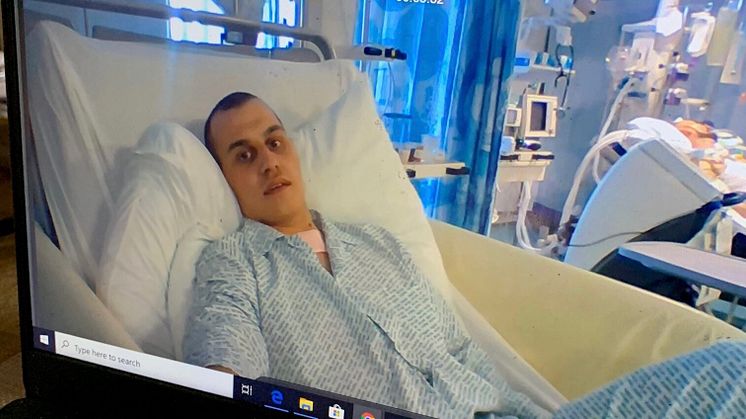
Press release -
Almost two hours of CPR saved Asbjørn’s life
The young seaman Asbjørn Morell was healthy, in good health and fit, when he most unexpectedly suffered a cardiac arrest in the North Sea. His colleagues on board the vessel ‘Esvagt Cantana’ fought for hours to save him.
Shortly before 1 am on the night between April 17th and April 18th, the phone rang in Judith Morell’s bedroom in Vejen.
‘No caller ID’. She pressed ‘decline’ and closed her eyes to fall back to sleep.
An SMS checked in from ESVAGT Crewing: ‘Call regarding Asbjørn’.
‘I was fully awake straight away; woke my husband and called back. It’s one of those conversations that you never hope to have’, says Judith Morell.
 The message wasn’t pleasant. Judith and Bjarke Morell’s 19-year-old son Asbjørn, who works on board the ’Esvagt Cantana’ in the North Sea, had suffered a cardiac arrest and collapsed. He was unconscious and currently in a rescue helicopter on his way to the Royal Infirmary in Aberdeen, far away from Vejen.
The message wasn’t pleasant. Judith and Bjarke Morell’s 19-year-old son Asbjørn, who works on board the ’Esvagt Cantana’ in the North Sea, had suffered a cardiac arrest and collapsed. He was unconscious and currently in a rescue helicopter on his way to the Royal Infirmary in Aberdeen, far away from Vejen.
‘We heard it, but we didn’t understand’, remembers Judith Morell:
‘We had received a snap from him that day; he was in a good mood, in shape and healthy. It didn’t make sense’.
Collapsed
 Asbjørn’s work as ordinary seaman on the ‘Esvagt Cantana’ requires solid seamanship skills. The vessel is an ERRV vessel delivering standby services to an oil and gas production unit in the North Sea, and the vessel has to be able to assist with tasks and rescue capabilities for the platform’s staff.
Asbjørn’s work as ordinary seaman on the ‘Esvagt Cantana’ requires solid seamanship skills. The vessel is an ERRV vessel delivering standby services to an oil and gas production unit in the North Sea, and the vessel has to be able to assist with tasks and rescue capabilities for the platform’s staff.
You need to be in good shape to make a difference in an acute situation, and the crew therefore spends a lot of timing training and practising skills at sea, as well as working out in the vessel’s fitness room.
In the evening, Asbjørn and his colleague Lasse Lebeck were sweating on the treadmill in the fitness room. The workout was going well, until Asbjørn suddenly collapsed.
‘I used to work for the Danish Defence before I started sailing’, says the 25-year-old Lasse Lebeck:
‘I have seen people experience heat strokes or hit the wall due to a too intense effort, so I thought it was that. I felt Asbjørn’s heart rate in his wrist, put him into recovery position and went to get help from a colleague. We raised the alarm to the bridge and checked his heart rate again – now it was gone. I found it by his throat, but shortly after, it also disappeared there. Then we got to work with oxygen, cardiac massage and the defibrillator’, says Lasse Lebeck.
104 minutes without any heartbeat
Other colleagues arrived and got into an effective rhythm, taking turns performing cardiac massage on Asbjørn.
 ‘When one of us slowed in cadence, somebody else took over. We were all three in good shape and kept going. We didn’t exactly lack motivation. The first 45 minutes went by like this’ says Lasse Lebeck and snaps his fingers.
‘When one of us slowed in cadence, somebody else took over. We were all three in good shape and kept going. We didn’t exactly lack motivation. The first 45 minutes went by like this’ says Lasse Lebeck and snaps his fingers.
But 45 minutes is a very long time to be without a heartbeat.
Just before the medics from the requested rescue helicopter arrived, Asbjørn’s heart rate reappeared. By that time, Asbjørn had received heart massage for 104 minutes. He had also gotten five counter-shocks from the defibrillator, but – there was literally no sign of life in him. Now it was finally happening.
‘The medics connected electrodes and tubes and other things to him. He received an injection through a syringe that made him cramp completely up’, says Lasse Lebeck.
The crew assisted the medics for another two hours, before Asbjørn’s condition was stable enough for him to be hoisted on a stretcher from the vessel’s depth up into the helicopter that was ready to make for Aberdeen.
Once the helicopter was on its way towards Aberdeen, the reaction came.
‘All of us who had performed CPR and worked on Asbjørn were overjoyed. We had made a difference; Asbjørn’s heart rate was back, and we were euphoric. On deck, I took one of Frederik’s cigs. I don’t smoke otherwise, but I could do with one right then’, says Lasse Lebeck:
‘But for the others on board, the waiting time was excruciatingly long. It certainly couldn’t have been fun to be on the bridge for hours and not be able to do something’, says Lasse Lebeck.
Didn’t want to wake up
The time was also passing by slowly in Vejen. At 4 am, the family heard from the doctor in Aberdeen. Asbjørn’s condition was stable and he was in a coma; cooled down to 33 degrees.
It was only then that the family found out that Asbjørn had been without a heartbeat for almost two hours.
‘We were told that the only reason he was still alive was thanks to the terrific work that the crew on board had performed. But we were also told that it was critical that he had been without a heartbeat for so long’, says Judith Morell.
The doctors explained that they over the next few days would slowly warm Asbjørn up and try to wake him. Those days went by with bated breath.
‘Due to the Covid-19 restrictions, we were not allowed to go to Aberdeen and visit him. The only exception to that rule was for births and to say farewell. Not being able to be with him was awful. But it also became a bright spot for us. As long as we weren’t allowed to visit him, he wasn’t dying. That’s how we interpreted it’, says Judith Morell.
 Instead, the family called the hospital twice a day on their iPad to look at their sleeping son. Judith Morell sang for him, and Bjarke Morell read bedtime stories. But there was no reaction.
Instead, the family called the hospital twice a day on their iPad to look at their sleeping son. Judith Morell sang for him, and Bjarke Morell read bedtime stories. But there was no reaction.
‘Check-ups and scannings showed, that he was fine, but they couldn’t wake him up. We had read up on sequelae from longer cardiac arrests, and it didn’t look good. The doctors weren’t optimistic either. We prepared ourselves for him to be severely brain-damaged.
Broken bones
But then, after ten days seeing Asbjørn in a coma, there was finally a breakthrough for the family.
‘One morning where we were skyping with the hospital, I was confused by the nurse saying that “...Asbjørn wasn’t talking much”. I knew that, because he was in a coma. But then, she turned the screen around, and there was Asbjørn, sitting up and stretching his arm towards us. It was a completely indescribable feeling’, says Judith Morell:
‘We had prepared for the worst. We didn't know if he could recognise us, but now he was sitting up. That was a good sign.’
The day before, the doctors had discovered that Asbjørn had good – and far less serious – reasons not to wake up. Lasse and the other crew members had put their shoulder to the wheel when giving Asbjørn heart massage. A scanning showed that they, during the process, had broken eight ribs and the sternum on Asbjørn.
‘Every time he tried to breathe on his own, he would collapse again. But once they repaired his chest, his condition really improved’, says Judith Morell.
After a week, Asbjørn was ready to leave the intensive care unit and move to the cardiology department. And 14 days after the cardiac arrest, the family knew that their son would become his old self again.
 ‘That day when we were talking with a nurse and heard that Asbjørn had started flirting with the nurses, there was no doubt anymore: It was definitely the same boy’, says Judith Morell.
‘That day when we were talking with a nurse and heard that Asbjørn had started flirting with the nurses, there was no doubt anymore: It was definitely the same boy’, says Judith Morell.
Three weeks after his cardiac arrest, Asbjørn was transferred to the Odense University Hospital back home in Denmark – 20 kg lighter.
Here, he underwent a six-hour long bypass surgery and had an ICD-pacemaker implanted behind his left shoulder blade. The doctors also gave their word that he is a miracle.
‘It turned out that a main vein to my heart was too short from birth. That’s also why I was always quickly out of breath, even though I was in good shape. And that’s why I suffered a cardiac arrest’, says Asbjørn.
Deliverance and happiness
Back home, Asbjørn focused on recovery and rehabilitation by exercising as much as the eight broken ribs would allow. He talked with friends, family and a psychologist – and experienced a complete meltdown at a time where he least expected it.
‘I was at a party with some friends and was listening to Nik & Jay’s song “One day left”. Then I cried my eyes out for 15 minutes, I had a breakdown. It took me by surprise, but it was also a deliverance’, says Asbjørn Morell.
He was also in Esbjerg to greet his colleagues on the ‘Esvagt Cantana’, and in October, the doctors gave him the go-ahead to return back on board.
‘I feel the same way as before the incident’, says Asbjørn:
‘2-3 weeks are completely erased from my memory and will likely never return. I can’t remember any knots anymore, but otherwise, everything is normal’, he says.
‘You didn’t know any knots before either’, says Lasse Lebeck with a laugh.
 The comradeship and bad jokes have resumed. And everybody appreciates that. And even though Asbjørn has to let his colleagues know before going to the fitness room to work out, it’s back to everyday life on the ‘Esvagt Cantana’.
The comradeship and bad jokes have resumed. And everybody appreciates that. And even though Asbjørn has to let his colleagues know before going to the fitness room to work out, it’s back to everyday life on the ‘Esvagt Cantana’.
‘It’s wonderful to be back. And it was great to see the lads again. I know who to thank for being alive – and they also know’, says Asbjørn Morell.
Should they ever begin to have doubts, a 2x1-metre big mosaic in Lego emphasizes that the Morell family will forever be grateful to the crew for not giving up on Asbjørn. An achievement that got Judith and Bjarke Morell to nominate ‘Esvagt Cantana’s crew for the 2021 Heart Saving Award handed out by the Danish Heart Association (Årets Hjerteredder-pris 2021 i Hjerteforeningen).
 ‘I just cannot express how grateful we are that they didn’t give up on Asbjørn. Even after an hour they kept on going, on and on and on. It is exclusively thanks to the crew that there was still hope when the rescue helicopter arrived after almost two hours’, says Judith Morell.
‘I just cannot express how grateful we are that they didn’t give up on Asbjørn. Even after an hour they kept on going, on and on and on. It is exclusively thanks to the crew that there was still hope when the rescue helicopter arrived after almost two hours’, says Judith Morell.
 ‘Sending him off to work again made my heart beat an extra time. But – I know perfectly well that he is absolutely in the best hands possible if something were to happen’ says Judith Morell (2nd from right), Asbjørn’s mother.
‘Sending him off to work again made my heart beat an extra time. But – I know perfectly well that he is absolutely in the best hands possible if something were to happen’ says Judith Morell (2nd from right), Asbjørn’s mother.
Related links
Topics
Categories
About ESVAGT
ESVAGT is a dedicated provider of safety and support at sea and a market leader within offshore wind solutions.
We support the offshore Oil & Gas industries with a wide range of specialized services: Standby, Emergency Response and Rescue Vessels (ERRV), Oil spill response, Firefighting, Tanker assists, Rig moves, Supply services and Interfield transfer of cargo and personnel.
We service offshore wind farms and have a fleet of dedicated Service Operation Vessels (SOV), which ESVAGT pioneered in 2010. The SOVs provide accommodation for technicians, spare time facilities, offices and conference room, storage for small turbine parts, workshops, etc. The SOV offers flexible personnel and equipment transfer capabilities by either Walk-to-Work gangway system or Safe Transfer Boats.
ESVAGT was founded in 1981 and has a fleet of more than 40 vessels and approximately 1000 employees on- and offshore.



